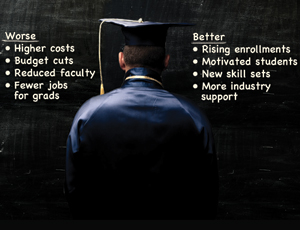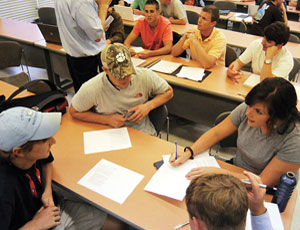Gainesville, Fla., may be warm most of the time, but the job market facing students at the University of Florida’s M.E. Rinker School of Building Construction has been downright chilly. Only 50 industry firms showed up at its fall job fair, down from 115 with 15 on a waiting list in spring 2007. In years past, the school placed 95% of graduating seniors and master’s students, but only 50% so far in 2009.


The downturn has hit engineering and construction programs on campus, and for many used to better times, it comes as a shock. But ever the innovators, schools are finding ways to be more frugal and make graduates more competitive and productive in a changing industry. Some programs also are benefitting from an enrollment upsurge as prospects await job-market improvements and seek new and enhanced skill sets. “There is a need to develop ‘transformer’ students who can quickly adapt,” says Craig Capano, head of the civil, construction and environment department at Wentworth Institute of Technology, Boston.
Even with reduced job-fair attendance, cuts in state funding and a shrinking endowment, the Rinker school, the nation’s largest construction-management program, has managed to avoid major cutbacks, says director Abdol R. Chini. He says the hard times are toughening graduates even before they step onto a jobsite. When prospects seemed endless, “some students did not push themselves to the limit. I was not seeing that level of effort,” Chini says. “Now that the market has changed, they are working hard. That is a positive thing, in my opinion.”
New World
But it is tough out there in academia, particular for large public universities. “We had 10% furloughs this year,” says Mohammed Noori, dean of the engineering school at California Polytechnic State University, San Luis Obispo. The highest ranked public, non-military program by the U.S News & World Report, it faced up to 15% budget cuts and had to reduce this year’s freshman class by 10%. “We cannot hire any new faculty, and with fewer students, can better manage our resources,” he says. The school is ramping up private-sector fund-raising, which Noori says should be an industry obligation. “We produce 11% of the state’s engineering workforce,” he says.
Iowa State University faces a new state-ordered 10% funding cut this year, on top of a 7% decrease earlier this year, says Ed Jaselskis, head of the school’s construction engineering and management program. But thanks to some funding from the American Recovery and Reinvestment Act, the “blow has not been so bad this year,” he says.
Industry realities have hit home this year for others as well. Students in Auburn University’s McWhorter School of Building Science, Auburn, Ala., typically stayed close to home after graduating. But when an interview sign-up sheet was posted for a job in Alaska, time slots filled quickly. The construction science and management department at Clemson University, Clemson, S.C., had enjoyed a 96% hiring rate for grads since it was founded three decades ago, but not this year, says Roger W. Liska, department chairman. Placements dropped to 70%.
Manhattan-based Kansas State University, like other schools, is evaluating program efficiency to weather its budget shortfall. Faculty is “just shouldering more load and getting it done,” says Dave Fritchen, head of the school’s architectural engineering and construction science programs.
Clarence Waters, director of the architectural engineering program at the University of Nebraska, Lincoln, says for the first time in his career, he is worried about what students will face when they graduate. But beyond that hurdle, Waters sees a bright future, especially for students who will be designing energy-efficient buildings and retrofits for buildings.
Even with the hiring slump and budget cuts, schools say interest in engineering and construction is not waning as students turn away from the lure of now-evaporating megasalaries in finance and consulting and see a career in the industry as a way to effect global change.
Enrollment is up 70% for Clemson’s graduate programs, says Liska. Students are entering the civil, construction and environmental engineering department at the University of Alabama, Tuscaloosa, in “record-breaking” numbers that include more business-major transfers, according to Ken Fridley, program head. At the now merged...




Post a comment to this article
Report Abusive Comment